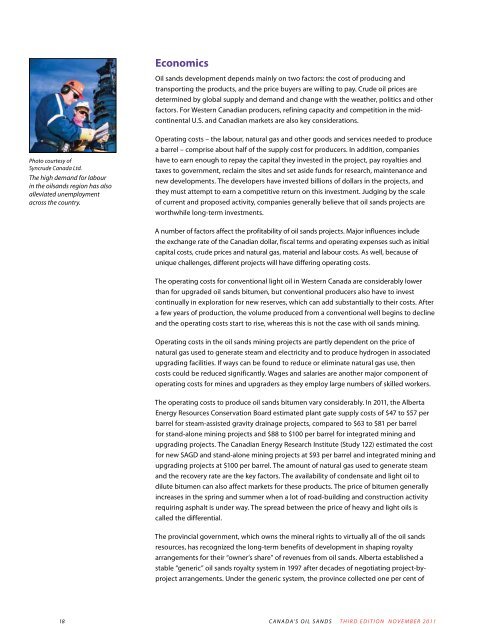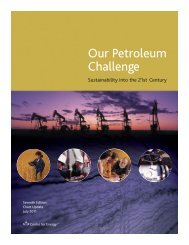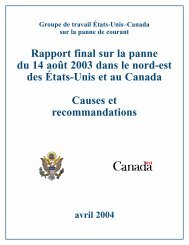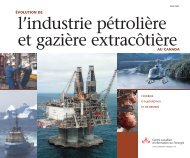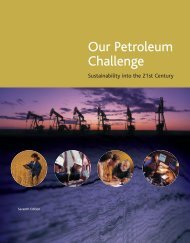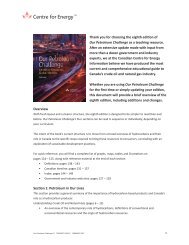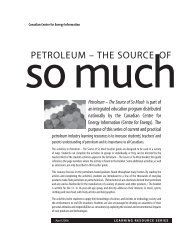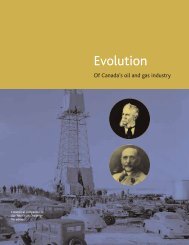Canada's Oil Sands - Centre for Energy
Canada's Oil Sands - Centre for Energy
Canada's Oil Sands - Centre for Energy
You also want an ePaper? Increase the reach of your titles
YUMPU automatically turns print PDFs into web optimized ePapers that Google loves.
Economics<br />
<strong>Oil</strong> sands development depends mainly on two factors: the cost of producing and<br />
transporting the products, and the price buyers are willing to pay. Crude oil prices are<br />
determined by global supply and demand and change with the weather, politics and other<br />
factors. For Western Canadian producers, refining capacity and competition in the midcontinental<br />
U.S. and Canadian markets are also key considerations.<br />
Photo courtesy of<br />
Syncrude Canada Ltd.<br />
The high demand <strong>for</strong> labour<br />
in the oilsands region has also<br />
alleviated unemployment<br />
across the country.<br />
Operating costs – the labour, natural gas and other goods and services needed to produce<br />
a barrel – comprise about half of the supply cost <strong>for</strong> producers. In addition, companies<br />
have to earn enough to repay the capital they invested in the project, pay royalties and<br />
taxes to government, reclaim the sites and set aside funds <strong>for</strong> research, maintenance and<br />
new developments. The developers have invested billions of dollars in the projects, and<br />
they must attempt to earn a competitive return on this investment. Judging by the scale<br />
of current and proposed activity, companies generally believe that oil sands projects are<br />
worthwhile long-term investments.<br />
A number of factors affect the profitability of oil sands projects. Major influences include<br />
the exchange rate of the Canadian dollar, fiscal terms and operating expenses such as initial<br />
capital costs, crude prices and natural gas, material and labour costs. As well, because of<br />
unique challenges, different projects will have differing operating costs.<br />
The operating costs <strong>for</strong> conventional light oil in Western Canada are considerably lower<br />
than <strong>for</strong> upgraded oil sands bitumen, but conventional producers also have to invest<br />
continually in exploration <strong>for</strong> new reserves, which can add substantially to their costs. After<br />
a few years of production, the volume produced from a conventional well begins to decline<br />
and the operating costs start to rise, whereas this is not the case with oil sands mining.<br />
Operating costs in the oil sands mining projects are partly dependent on the price of<br />
natural gas used to generate steam and electricity and to produce hydrogen in associated<br />
upgrading facilities. If ways can be found to reduce or eliminate natural gas use, then<br />
costs could be reduced significantly. Wages and salaries are another major component of<br />
operating costs <strong>for</strong> mines and upgraders as they employ large numbers of skilled workers.<br />
The operating costs to produce oil sands bitumen vary considerably. In 2011, the Alberta<br />
<strong>Energy</strong> Resources Conservation Board estimated plant gate supply costs of $47 to $57 per<br />
barrel <strong>for</strong> steam-assisted gravity drainage projects, compared to $63 to $81 per barrel<br />
<strong>for</strong> stand-alone mining projects and $88 to $100 per barrel <strong>for</strong> integrated mining and<br />
upgrading projects. The Canadian <strong>Energy</strong> Research Institute (Study 122) estimated the cost<br />
<strong>for</strong> new SAGD and stand-alone mining projects at $93 per barrel and integrated mining and<br />
upgrading projects at $100 per barrel. The amount of natural gas used to generate steam<br />
and the recovery rate are the key factors. The availability of condensate and light oil to<br />
dilute bitumen can also affect markets <strong>for</strong> these products. The price of bitumen generally<br />
increases in the spring and summer when a lot of road-building and construction activity<br />
requiring asphalt is under way. The spread between the price of heavy and light oils is<br />
called the differential.<br />
The provincial government, which owns the mineral rights to virtually all of the oil sands<br />
resources, has recognized the long-term benefits of development in shaping royalty<br />
arrangements <strong>for</strong> their “owner’s share” of revenues from oil sands. Alberta established a<br />
stable “generic” oil sands royalty system in 1997 after decades of negotiating project-byproject<br />
arrangements. Under the generic system, the province collected one per cent of<br />
18 CANADA’S OIL SANDS THIRD edition November 2011


